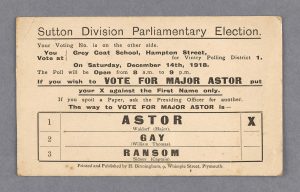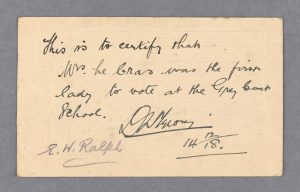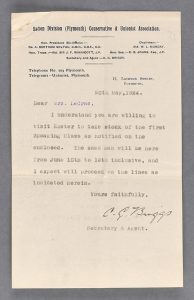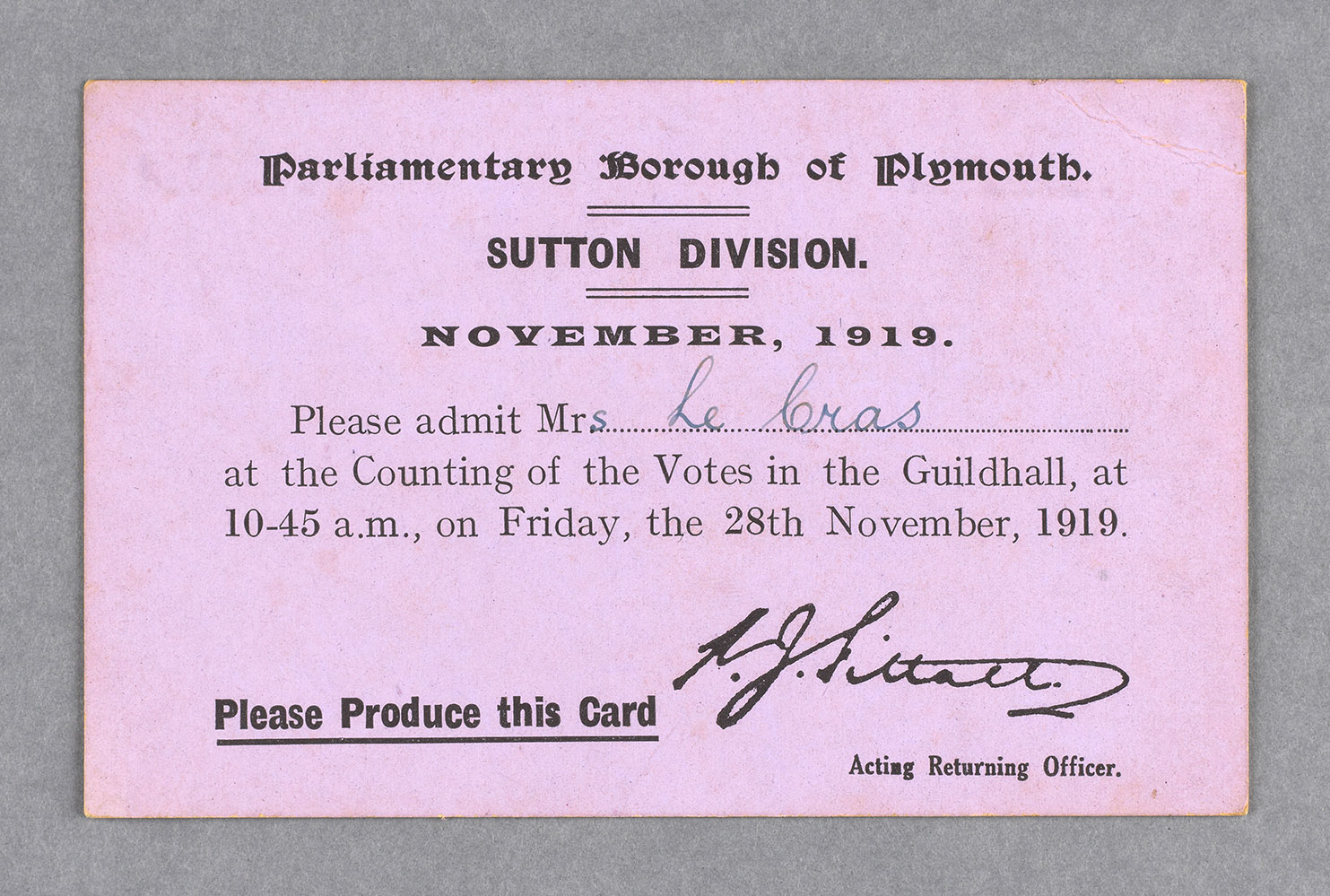28 November 2019 marks the hundredth anniversary of the election of Nancy Astor as the first woman MP to take her seat in the House of Commons, following a closely fought by-election at Plymouth. A couple of years ago the Parliamentary Archives acquired material relating to a certain Bessie Le Cras, who had supported the Astor campaign. But who was Le Cras, and what was her real significance to the campaign? Vote100 volunteer Oonagh Gay reveals all in this blog first published on the UKVote100 blog.
Bessie Le Cras was one of the Conservative campaigners and agents at the Plymouth Sutton by-election on 15 November 1919. The Parliamentary Archives acquired signed letters from Nancy Astor and her constituency secretary/election agent C.G. Briggs, and a series of circulars, newspaper cuttings and cards. The items either came from Astor’s Plymouth address, 3 Elliot Terrace, The Hoe, or from the registered address of Plymouth Conservative and Unionist Association. Le Cras was not the principal election agent for Astor – this was the professional agent, Briggs, but Nancy clearly knew and appreciated her help, evidenced by personal letters and thank yous. Yet Le Cras came from a humble background, and was not the type of wealthy lady campaigner. which we might have expected to find assisting Astor.
Her story illustrates the importance of the working class Conservative vote in the election of Astor in Plymouth Sutton, which was not a typical Conservative constituency. Within its boundaries were important dockyards, associated industry and small terraced housing. We do not know how Le Cras became involved in Conservative politics in Plymouth, but we can set out what is known from public records.
Bessie Philips was born in Jersey on 30 April 1876. She came from a working class background (her father was a labourer and her mother was a laundress); she became a domestic servant. She married Philip Bisson Le Cras, on 2 February 1898 at St Helier when she was 22. Bessie was Philip’s second wife; the first was Beatrice Mallowby who died in 1897- no doubt one motivation for the second marriage was to find a carer for Beatrice’s four surviving children with Philip, the last being born only in 1897. Bessie went on to have at least seven children of her own.
Sometime in 1903 Le Cras family moved to Plymouth. The likelihood that this was due to the need to find work. Official records hint at some desperation. One son, Herbert Clarence, was left behind, aged 8, and placed in Jersey Home for Boys by his father in May 1903. He was described as illiterate, but by the time he left the Home in 1912, he had learned a trade. He is not recorded as having returned to live with his parents and siblings at a later point.
Bessie Le Cras probably needed to work even after marriage. Philip’s occupation varied, according to official census returns. In 1881 he was a baker, in 1901 a market gardener, in 1911 he was a medical electrician and masseuse, working from home. By the time of the national register of 1939 (which was used for issuing identity cards) he is described as a retired medical herbalist. The suspicion is that his employment was never secure.
In 1911 the family’s address in Plymouth was 84 Cromwell Road. By the time that Bessie became a counting agent for Nancy Astor, her family address was 58 Ebrington Street and they remained there for some decades, appearing there on the 1939 electoral register, and dying there on 11 November 1957. Philip lived to be 100, dying in 1965 in Plymouth.
Bessie’s home, Ebrington St, was in the Vintry ward of the Plymouth Sutton constituency and a working class area. Lady Astor established a Victory Club there in 1919 for poor local children. This provides a possible clue to Le Cras’ involvement in the electoral contest of 1919. Bessie was an enthusiastic supporter of women’s suffrage, being the first woman to vote for Major Astor at Greycoat School in December 1918. This general election was the first at which women over 30 who met a property qualification could vote. Among the papers acquired by the Parliamentary Archives was a certified note, on the back of a Conservative polling guide, that Le Cras had been the first lady to vote there:
 Among her personal papers deposited with the Parliamentary Archives was a WSPU badge dated 1909 (LCR/7/1). We do not know if the badge belonged to her, or whether it was acquired later. We have not found any evidence of her involvement in either the militant suffragette campaigns, or in suffragist movements before the First World War. So the extent of her pre-war involvement in winning the vote remains a mystery.
Among her personal papers deposited with the Parliamentary Archives was a WSPU badge dated 1909 (LCR/7/1). We do not know if the badge belonged to her, or whether it was acquired later. We have not found any evidence of her involvement in either the militant suffragette campaigns, or in suffragist movements before the First World War. So the extent of her pre-war involvement in winning the vote remains a mystery.
The November 1919 by-election
Lady Astor’s husband was elevated to the peerage in 1919 and the local Conservative association endorsed Lady Astor as the by-election candidate. As usual, Briggs was appointed the election agent. He was an experienced professional election agent working at Plymouth since at least 1904, but as was common at the time, also recruited local people such as Le Cras to act as counting agents. Electoral law had made provision for party workers to act as counting agents at the count since the Ballot Act 1871, which introduced the secret ballot. Counting agents checked that the staff of the Returning Officer undertook the count correctly and fairly.
This was an official appointment for Le Cras which had to be approved by the Returning Officer under electoral law:
It was not until the Representation of the People Act 1918 that compiling the electoral register became the central duty of the local authority. Until that date, parish overseers compiled voters’ lists which were then considerably altered by the major political parties. Party supporters canvassed annually to identify and register supporters, and to challenge the validity of voters, likely to object where possible to the inclusion of non-supporters. Annual revision courts were held every autumn. This activity was pioneered after the 1832 Reform Act by Thomas Jones Philips, an energetic Conservative election agent in Wales, who recently featured on the TV programme Who Do you Think You Are?
Following the Corrupt and Illegal Practices Act 1883, paid canvassers could no longer be used to identify potential electors, which meant that volunteers would need to be recruited to replace them. The Act and associated legislation restricted the number of payments which could be made to party workers by the candidate’s agent. The late nineteenth century therefore saw a great increase in the number of volunteer party workers who canvassed at elections and a professionalisation of election agents, who could superintend their work.
Kathryn Rix from the History of Parliament Trust, has published extensively on the growth of party electoral organisation and professional election agents in the late nineteenth century, Her blog for UK Vote 100 featured the first women professional election agents, who worked for the Liberal Party. These women came from upper middle class backgrounds, and it is likely that Le Cras’ background and family circumstances precluded her from reaching such a senior position as a Conservative agent.
The Conservative Party could draw on substantial support from women in its Primrose League. The League, founded in 1883 to honour the memory of former Prime Minister Benjamin Disraeli and to popularise Conservative principles. quickly spread across the United Kingdom. Each constituency commonly had a local branch or habitation. At one time the Primrose League was the largest party organisation in the United Kingdom, with over one million members, of whom half were female.
At election time, despatch of party literature, canvassing and fundraising were essential – all activities which could be undertaken both by middle class ladies and working women. The Primrose League attracted significant working class support, with regular social events, and played a major role in checking the canvass of electors annually. The growth of local elections also meant that electoral activity was maintained on a regular basis. During the 1919 by-election thousands of electoral circulars were despatched by the Plymouth Sutton habitation.
An item from the Parliamentary Archives indicates that Le Cras had connections with the League. (LCR/1/5 5 Dec 1919) Briggs as agent would have known of the important role that working class women could play in the contest – given the industrial focus of Plymouth Sutton. Here Le Cras would be invaluable. Karen J Mussoff found in her study of the rhetorical style of the by-election that Astor deliberately scheduled meetings for women between 3 and 5pm so she could address them informally, and present herself as a caregiver.
We do not know whether Le Cras received any remuneration for her work in the election campaign. The papers of Lady Astor at Reading University does not list her as having received any payment from Briggs. In fact Le Cras was responsible for collecting donations to buy Lady Astor a silver rose bowl at the occasion of her election in 1919 and made small donations to Conservative funds in the 1920s, according to receipts found in her papers.
However it seems unlikely that she was wealthy, given that she continued to live close to the docks during her life in Plymouth. There is no record of her ever visiting the Astor home of Cliveden and she does not seem to have held prominent positions in Plymouth Conservative women’s associations.
In a three-cornered contest , Lady Astor retained 51 per cent of the vote and was elected with a majority of 5000, albeit with a 14 per cent swing against the Conservatives. Her principal opponent was a Labour man, indicating the importance of the working class vote. The results were:
Nancy Astor Unionist 14,495
Isaac Foot Liberal 4,139
William Thomas Gay Labour 9,292
Gay was a member of the left-wing Independent Labour Party and had pacifist connections during the First World War – not likely to endear him to a naval constituency such as Plymouth. He was the manager of the local Co-Op boot factory. Nevertheless his vote increased by 4000 over his candidature at the 1918 election. Foot suffered from the splitting of the Liberal vote following the decision of Lloyd George to remain in coalition with the Conservatives after the end of the First World War. He was the father of Michael Foot, leader of the Labour Party 1980-83.
Astor continued to face formidable opposition at subsequent elections, until her final defeat in 1945. Plymouth Sutton was by no means a safe seat. In 1929, for example, she held the seat by just 211 votes. The Astor archives reveal much about the internal politics on her local Conservative association, as she faced a backlash against her support for temperance and opposition from the brewing industry.
Yet the papers of Lady Astor held at Reading University do not appear to contain anything relating to Le Cras. This is puzzling, as we have correspondence in the Parliamentary Archives which indicates a continuing relationship. Astor sent her thank you postcards, after the 1922 election (LCR/1/6). Briggs asked for Le Cras to organise a function in the Vintry ward (LCR/3/5). In 1924 he asked her to ‘take stock of the first speaking class as noticed on a printed handbill for the National Unionist Association Speakers Classes. (LRC/3/9)

Le Cras was responsible for organising printing of some leaflets for the 1922 election campaign (LCR/10) and most likely the reference to ‘Madam’ in a thank you letter in relation to helping with the annual canvass in 1927 relates to Bessie (LCR/11). The most likely explanation is that Le Cras was a minor figure in the politics of Plymouth Sutton and so any correspondence from Lady Astor to her survived only because Le Cras kept it in her own collection.
We can gain some further insights in press archives. Le Cras was mentioned in the Western Morning News 6 June 1921 as a fundraiser for Vintry Unionist Association. She wrote to the News in support of Astor on 22 August 1922, when Astor’s views on the sale of alcohol were under attack. She appears to have remained a Conservative and Unionist voter, but there is no further record of personal contact with Astor. This is unsurprising as Le Cras moved in a different social circle to the wealthy socialite world of the Astors.
However, there is evidence that her family was prospering. The Hampshire Telegraph 5 July 1918 recorded the awarding of an assistant clerkship in the Royal Navy to her son Philip Cyril; in 1930 there was a short account of the wedding of her daughter in the Western Morning News on 26 September, suggesting that the family had a certain social status locally. Any further details about Bessie Le Cras and her family would be welcomed by the Parliamentary Archives.
Images courtesy of Parliamentary Archives
Sources and further reading
This blog post was first published in full on the UKVote100 blog on 12 November 2019
Papers of Nancy Astor https://www.reading.ac.uk/special-collections/collections/sc-astor-nancy.aspx
Papers of Bessie Le Cras https://archives.parliament.uk/collections/getrecord/GB61_LCR
F W S Craig. British Parliamentary Election Results 1918-49 (1983)
Kathryn Rix. Parties, Agents and Electoral Culture in England 1880-1910 (2016) https://wordpress.com/read/blogs/42179464/posts/2497
Kathryn Rix. The Lady Liberal Agent: Bertha Fischer (1875-1920) and Ellen Pocock (1854-1943). UK Vote 100 blog 15 February 2017
https://ukvote100.org/2017/02/15/the-lady-liberal-agent/
Kathryn Rix. Astor’s agent: the professional career of Christopher Briggs. Astor 100 blog 11 November 2019.
https://research.reading.ac.uk/astor100/astors-agent-the-professional-career-of-christopher-briggs/
Kathryn Rix. By-Elections and the Modernisation of Party Organisation 1867-1914 in By-Elections in British Politics 1832-1914 ed Thomas Otte and Paul Readman 2013
Kathryn Rix. “The backbone of the party: The Conservative agents, 1880-1910” Conservative History Journal Vol II Issue 7 2019
Alastair Cooke. A Gift from the Churchills 2010
Karen J Musoff. From Plymouth to Parliament: A Rhetorical History of Nancy Astor’s 1919 Campaign 1999 Macmillan
Western Morning News 21 August 1922 A Woman’s View
Philip Salmon. History of Parliament Trust blog 6 August 2019
https://victoriancommons.wordpress.com/2019/08/06/who-do-you-think-you-are-thomas-jones-phillips-1790-1843-pioneering-tory-election-agent/

